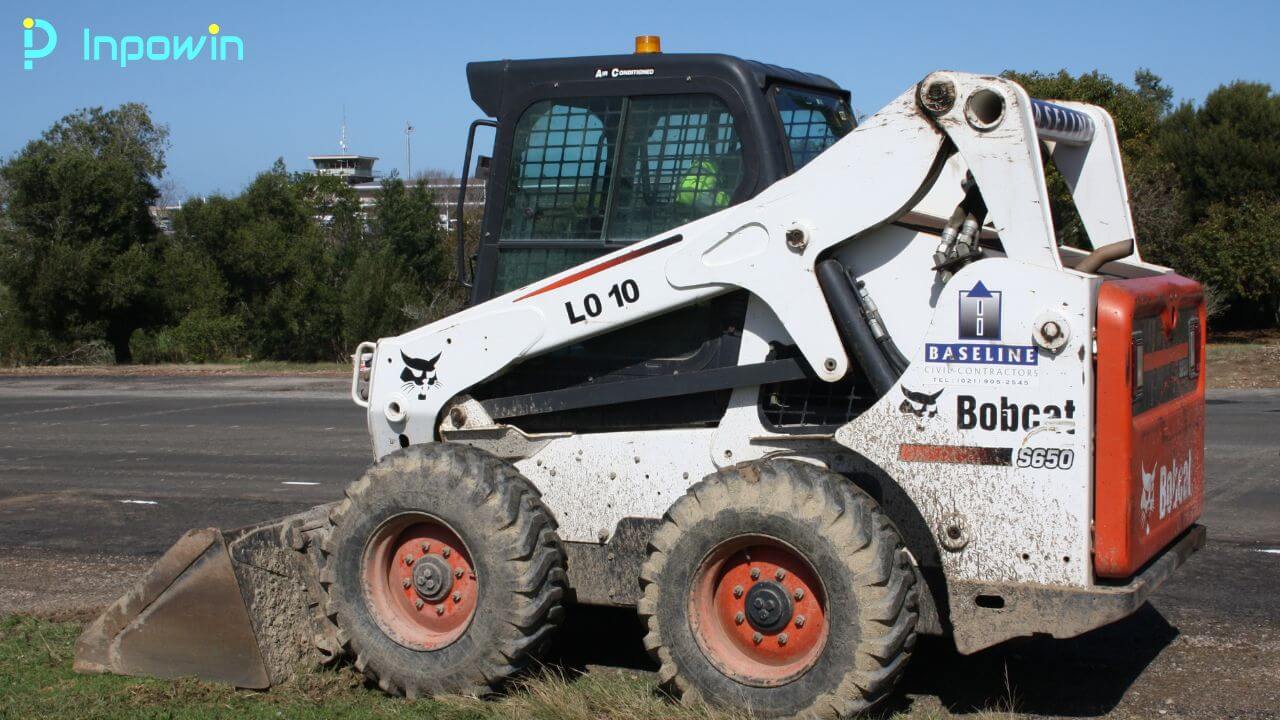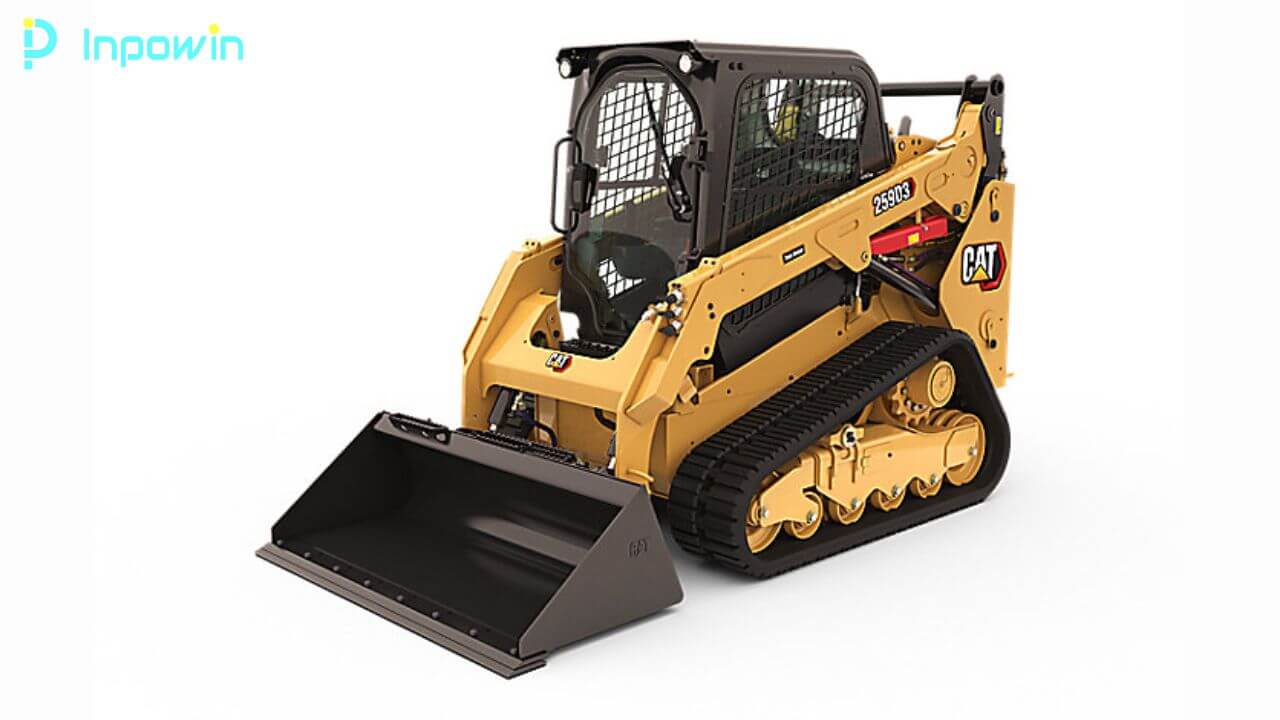Skid Steer Tracks vs Wheels – Skid steer loaders can be equipped with either tracks or wheels, and each option has its advantages and disadvantages depending on the intended use.
Tracks, also known as “rubber tracks,” are made of durable rubber and are ideal for working on rough or uneven terrain.
Wheels, on the other hand, are generally less expensive and more versatile than tracks.
They are faster and easier to maneuver on hard surfaces, making them a better choice for indoor or outdoor applications where speed and maneuverability are crucial.
However, wheeled skid steers are less stable than tracked machines, particularly on soft or uneven terrain.
Skid Steer Tracks vs Wheels
Here are the differences between Skin Steer Tracks and Wheels:
Wheeled Skid Steers

Wheeled skid steers are versatile machines that are commonly used in construction, landscaping, and agricultural applications.
They are designed to be compact, agile, and capable of operating in tight spaces, making them ideal for tasks such as excavation, grading, and material handling.
One of the primary advantages of wheeled skid steers is their speed and maneuverability.
They are capable of traveling at relatively high speeds, allowing operators to quickly move between job sites or cover large areas.
They also have a tight turning radius, which makes them ideal for working in confined spaces where a larger machine would be impractical.
Wheeled skid steers are also relatively easy to operate, with intuitive controls that allow operators to quickly master the basics.
They are typically equipped with a variety of attachments, such as buckets, forks, and augers, which allow them to perform a wide range of tasks.
However, wheeled skid steers also have some disadvantages.
They are less stable than tracked machines, particularly on rough or uneven terrain.
They also have a higher ground pressure, which can cause damage to delicate surfaces such as turf or pavement.
Finally, wheeled skid steers may require more maintenance than tracked machines, as the wheels and tires can wear out more quickly.
Cost and Maintenance of Tires Wheeled Skid Steers
The cost and maintenance of tires for wheeled skid steers can be a significant factor to consider when using these machines.
Here are some key points to keep in mind:
| Cost | Maintenance |
| The cost of tires for wheeled skid steers can vary widely depending on the size and type of tire needed. Generally, larger tires are more expensive than smaller ones. | Proper tire maintenance is important for maximizing the life of the tires and minimizing downtime for repairs. |
| Prices for new tires can range from a few hundred dollars per tire to over a thousand dollars per tire for high-performance models. | Regular inspections should be performed to check for damage or wear, such as cuts, punctures, or tread depth. |
| In addition to the initial purchase price, there may be additional costs for mounting, balancing, and disposing of old tires. | Proper inflation is also important, as underinflated or overinflated tires can cause uneven wear and reduce traction and stability. |
| Depending on the usage, tires may need to be rotated or replaced periodically to ensure even wear and maximum life. |
Overall, the cost and maintenance of tires for wheeled skid steers can add up over time, but proper maintenance and care can help extend the life of the tires and reduce overall costs.
It is important to factor in these costs when considering the overall cost of ownership for a wheeled skid steer.
Tracked Skid Steers

Tracked skid steers are versatile machines that are commonly used in construction, landscaping, and agricultural applications.
They are designed to be compact, agile, and capable of operating in tight spaces, while also providing superior traction and stability compared to wheeled skid steers.
Here are some advantages of tracked skid steers:
- Superior traction and stability: Tracked skid steers provide better traction and stability, particularly in muddy or soft soil. They distribute the machine’s weight more evenly, reducing ground pressure and minimizing damage to delicate surfaces.
- Maneuverability on rough terrain: Tracked skid steers are ideal for working on rough or uneven terrain, such as construction sites, logging operations, or agricultural fields.
- Reduced maintenance: Tracked skid steers generally require less maintenance than wheeled machines because they have fewer moving parts. There are no tires or wheels to maintain, and the tracks are designed to withstand the rigors of heavy use.
- Enhanced operator comfort: Tracked skid steers often provide a smoother ride and better shock absorption than wheeled machines. This can reduce operator fatigue and increase productivity.
However, there are some disadvantages to consider as well:
- Higher initial cost: Tracked skid steers can be more expensive than wheeled machines, with the initial cost of tracks being one of the major factors. However, this cost may be offset by the reduced maintenance costs over the life of the machine.
- Slower speed: Tracked skid steers are generally slower than wheeled machines, which can be a disadvantage when traveling longer distances or when speed is a critical factor.
- Reduced maneuverability on hard surfaces: Tracked skid steers can be more difficult to maneuver on hard surfaces such as concrete or asphalt. The tracks can cause damage to delicate surfaces, and the machine may be more difficult to turn or steer in tight spaces.
Overall, tracked skid steers are a powerful and versatile option for many different applications.
The choice between a tracked or wheeled skid steer will depend on the specific needs of the job and the terrain where it will be used.
Cost and Maintenance of Tires Tracked Skid Steers
The cost and maintenance of tracks for tracked skid steers can be a significant factor to consider when using these machines.
Here are some key points to keep in mind:
| Cost | Maintenance |
| The cost of tracks for tracked skid steers can vary widely depending on the size and type of track needed. Generally, larger tracks are more expensive than smaller ones. | Proper track maintenance is important for maximizing the life of the tracks and minimizing downtime for repairs. |
| Prices for new tracks can range from a few hundred dollars per track to several thousand dollars per track for high-performance models. | Regular inspections should be performed to check for damage or wear, such as cuts, tears, or worn-out treads. |
| In addition to the initial purchase price, there may be additional costs for installation, tensioning, and adjusting the tracks. | Proper tension is also important, as over-tightening or under-tightening the tracks can cause damage to the machine or reduce the life of the tracks. |
| Depending on the usage, tracks may need to be replaced periodically to ensure maximum life. |
Overall, the cost and maintenance of tracks for tracked skid steers can add up over time, but proper maintenance and care can help extend the life of the tracks and reduce overall costs.
It is important to factor in these costs when considering the overall cost of ownership for a tracked skid steer.
Read More: How-to proceed from history Dating errors
Conclusion
When considering tracks for a tracked skid steer, there are two primary options to choose from Skid Steer Tracks vs Wheels.
Here are some key differences between Skid Steer Tracks vs Wheels:
- Traction and stability: Steel tracks generally provide better traction and stability on soft or uneven terrain, while rubber tracks are better suited for hard surfaces. Steel tracks are also better able to handle heavy loads and tough conditions, making them ideal for construction or excavation work.
- Versatility: Rubber tracks are more versatile than steel tracks, as they can be used on a wider variety of surfaces and can adapt to changes in ground conditions. They are also less likely to cause damage to delicate surfaces such as turf or asphalt.
- Comfort and noise: Rubber tracks provide a smoother, quieter ride compared to steel tracks, which can be loud and uncomfortable for the operator.
- Cost: Steel tracks are generally more expensive than rubber tracks, but they can last longer and require less maintenance over time. Rubber tracks are less expensive upfront but may need to be replaced more frequently.
- Maintenance: Steel tracks require more maintenance than rubber tracks, as they need to be periodically adjusted and lubricated to prevent damage and wear. Rubber tracks are generally low maintenance, requiring only periodic cleaning and inspection.
Ultimately, the choice between steel and rubber tracks will depend on the specific needs of the job and the terrain where the machine will be used.
If the machine will primarily be used on soft or uneven terrain, steel tracks may be the best option.
If versatility and adaptability are more important, rubber tracks may be the better choice.
It’s important to consider both the upfront cost and the long-term maintenance and replacement costs when making a decision.